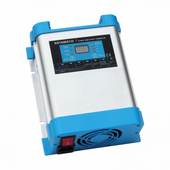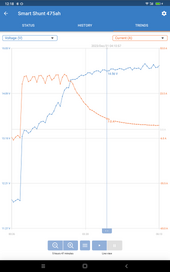40A-12V Intelligent 7 Stage Mains Battery Charger
I have been using this charger since November to compensate for zero solar this winter.
The bank is 5 X 100ah in parallel sealed lead acid, calcium.
I have noticed that this charger is doing its job for the 6 hours nighttime at my Economy 7 grid rate to bring the bank up to 100%.
The slight issue is that the charger reports 14.7volts but the Victron Smartshunt says the bank is ONLY 14.5 or 14.6 volts.
The charger only stays in bulk or boost, never float as it is designed to do after a full charge.
Are the batteries in danger of degradation due to this protocol?
There is not a lot I can do, without, say purchasing a very expensive Victron charger where I can manually set the voltages... This charger has set parameters and is currently set to the Wet battery config.
Cheers all.
I have been using this charger since November to compensate for zero solar this winter.
The bank is 5 X 100ah in parallel sealed lead acid, calcium.
I have noticed that this charger is doing its job for the 6 hours nighttime at my Economy 7 grid rate to bring the bank up to 100%.
The slight issue is that the charger reports 14.7volts but the Victron Smartshunt says the bank is ONLY 14.5 or 14.6 volts.
The charger only stays in bulk or boost, never float as it is designed to do after a full charge.
Are the batteries in danger of degradation due to this protocol?
There is not a lot I can do, without, say purchasing a very expensive Victron charger where I can manually set the voltages... This charger has set parameters and is currently set to the Wet battery config.
Cheers all.




